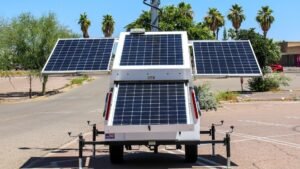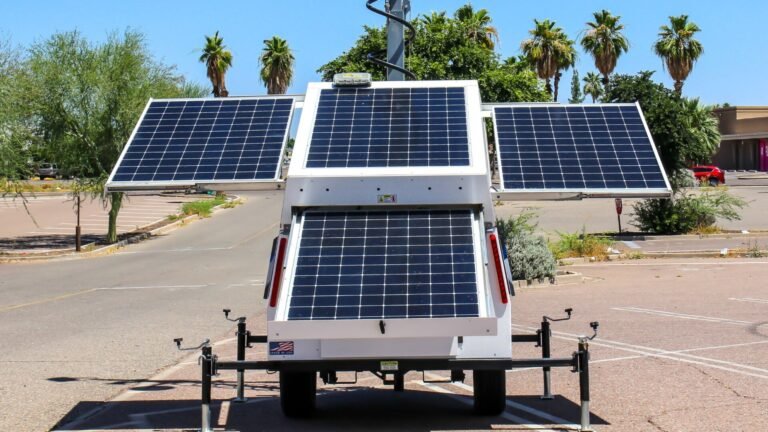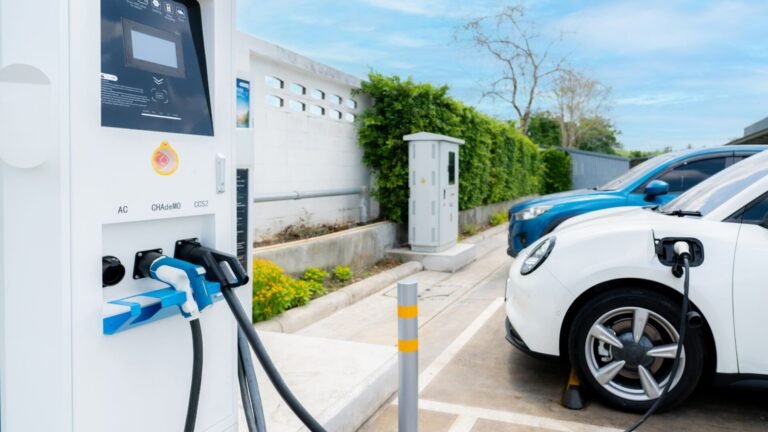Urban agriculture is undergoing a transformative shift thanks to the integration of vertical solar farms, a revolutionary approach that combines sustainable energy with efficient farming techniques.
This synergy between technology and nature represents a leap forward in urban resilience and food security. This innovative model is particularly suitable for cities, where space is at a premium and the demand for fresh, local produce is ever-increasing.
Vertical solar farms offer a multifaceted solution to urban sustainability challenges by maximizing land use, reducing energy consumption, and providing fresh produce to urban populations. By leveraging underutilized vertical spaces, they bring about a new era of farming within city landscapes.
This approach not only aligns with the global goals for sustainable development but also addresses urban food security concerns, making it a vital development in contemporary agriculture and a beacon for future urban planning strategies.
The Concept of Vertical Solar Farms
Vertical solar farms, or agrivoltaic systems, blend photovoltaic panels with vertical agriculture, allowing for the simultaneous production of electricity and crops.
This system utilizes vertically stacked layers to cultivate plants, thereby significantly reducing the land footprint compared to traditional farming methods.
The integration of solar panels above or alongside these plant layers serves multiple purposes: it generates clean energy, provides shade to plants, and utilizes urban spaces efficiently.
These systems can be installed on building rooftops, abandoned urban lots, or within existing structures, transforming underutilized urban spaces into productive agricultural hubs.
By doing so, vertical solar farms contribute to the revitalization of urban areas, turning them into centers of sustainability and green energy production.
Impacts on Urban Agriculture
The introduction of vertical solar farms into urban areas has profound implications for local food systems and energy sustainability:
- Increased Local Food Production: Vertical solar farms empower cities to significantly boost their self-sufficiency by producing a substantial portion of their own food.
This modern approach reduces reliance on distant rural agriculture and lengthy supply chains, which can be susceptible to disruptions caused by climate change or global events.
By cultivating crops locally, these innovative systems not only bolster the urban economy but also ensure that residents have access to fresher, more nutritious produce.
This paradigm shift supports a more resilient local food system and encourages urban residents to engage more actively with their food sources. - Energy Efficiency: The dual functionality of vertical solar farms as both food producers and energy generators marks a significant step towards urban sustainability.
By harnessing solar energy, these installations not only sustain their own vertical farming operations but can also supply excess power to nearby buildings, enhancing the overall energy efficiency of urban centers.
This model exemplifies a sustainable urban ecosystem, reducing reliance on fossil fuels and lowering the collective urban carbon footprint, thus contributing significantly to the fight against urban heat islands and climate change. - Water Conservation: In an era where water scarcity is becoming an increasingly critical issue, the water-saving capabilities of vertical solar farms present a game-changing solution.
These farms utilize advanced hydroponic or aeroponic systems, drastically cutting down water usage compared to conventional soil-based agriculture.
By integrating solar energy, they further reduce the environmental impact, creating a symbiotic system that conserves water while generating clean energy.
This approach not only addresses the urgent need for water conservation in urban areas but also sets a new standard for sustainable agricultural practices worldwide. - Year-Round Production: The controlled environment of vertical solar farms eliminates the constraints of traditional agriculture, allowing for the uninterrupted growth of crops regardless of external weather conditions.
This capacity for year-round production ensures a stable, continuous supply of fresh produce, which is particularly crucial in urban areas where space and favorable growing conditions are limited.
The ability to grow food throughout the year, regardless of seasonal changes, significantly bolsters urban food security and reduces the risk of food shortages, making cities more self-reliant and resilient. - Community Engagement: Beyond their environmental and economic benefits, vertical solar farms serve as vital hubs for community engagement and education.
They provide urban dwellers with a tangible connection to food production and renewable energy sources, fostering a greater understanding of sustainability issues.
These spaces can host workshops, school visits, and community programs, promoting green living and inspiring residents to adopt more sustainable lifestyles.
By integrating community engagement into their operations, vertical solar farms play a crucial role in cultivating a culture of environmental awareness and action among urban populations, contributing to the broader goals of sustainable urban development.
Challenges and Future Prospects
While vertical solar farms offer a groundbreaking approach to urban agriculture, they come with their own set of challenges. Initial investments for setting up these systems can be substantial, covering costs from advanced hydroponic systems to solar panel installation.
Moreover, the integration of technology demands a workforce skilled in both agriculture and renewable energy systems, which can be a significant hurdle in areas lacking such expertise.
Despite these challenges, the trajectory for vertical solar farms is on an upward curve, especially as technological advancements in 2024 continue to reduce costs and increase efficiency.
Innovations in lightweight, more efficient solar panels and automated farming technologies are making these setups more accessible and viable.
For instance, the integration of AI and IoT technologies for better energy and crop management is becoming more commonplace, enhancing productivity and reducing operational costs.
Furthermore, government incentives and subsidies aimed at promoting sustainable urban development are helping to alleviate the financial burden of initial setup costs.
As of 2024, cities around the globe are recognizing the value of vertical solar farms, with an increasing number of pilot projects and large-scale implementations showcasing their viability and benefits.
The adoption rates of vertical solar farming techniques are rising, with significant investments flowing into research and development to overcome existing barriers.
There is a growing trend of collaborative efforts between governments, private sectors, and educational institutions to foster innovation and scale these solutions.
The future outlook for vertical solar farms is optimistic. With the global population projected to increase, and urbanization rates climbing, the demand for sustainable, efficient, and local food production methods is more pressing than ever.
Vertical solar farms not only address this demand but also contribute to the creation of greener, more self-sufficient urban environments.
They represent a paradigm shift in how cities can approach food security, energy sustainability, and ecological balance, setting a precedent for future urban planning and development.
As these systems become more refined and widespread, they promise to play a central role in shaping the sustainable cities of tomorrow, making urban centers more resilient against the challenges of climate change, resource scarcity, and growing populations.
Tamesol’s Role and Vision
Tamesol, as a leader in sustainable energy solutions, recognizes the potential of vertical solar farms to revolutionize urban agriculture.
By integrating solar technology with innovative farming techniques, Tamesol is committed to supporting the development of sustainable urban ecosystems.
Our vision extends beyond energy production, aiming to foster communities that are self-sufficient, environmentally responsible, and forward-thinking.
Through collaboration and innovation, Tamesol is paving the way for a greener, more sustainable future in urban agriculture.






